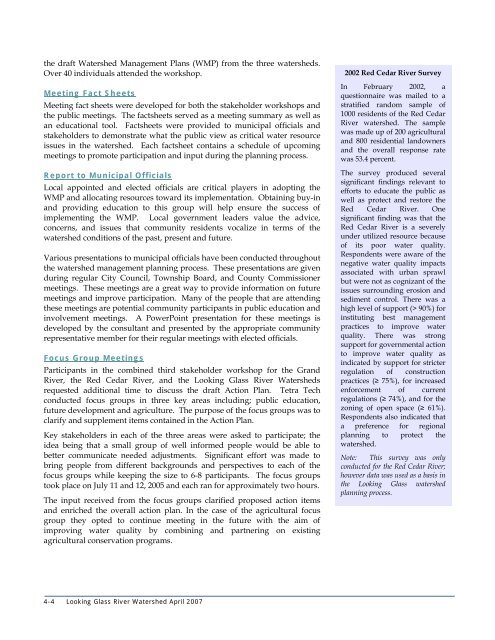Looking Glass River Watershed Management Plan - Greater ...
Looking Glass River Watershed Management Plan - Greater ...
Looking Glass River Watershed Management Plan - Greater ...
You also want an ePaper? Increase the reach of your titles
YUMPU automatically turns print PDFs into web optimized ePapers that Google loves.
the draft <strong>Watershed</strong> <strong>Management</strong> <strong>Plan</strong>s (WMP) from the three watersheds.<br />
Over 40 individuals attended the workshop.<br />
Meeting Fact Sheets<br />
Meeting fact sheets were developed for both the stakeholder workshops and<br />
the public meetings. The factsheets served as a meeting summary as well as<br />
an educational tool. Factsheets were provided to municipal officials and<br />
stakeholders to demonstrate what the public view as critical water resource<br />
issues in the watershed. Each factsheet contains a schedule of upcoming<br />
meetings to promote participation and input during the planning process.<br />
Report to Municipal Officials<br />
Local appointed and elected officials are critical players in adopting the<br />
WMP and allocating resources toward its implementation. Obtaining buy-in<br />
and providing education to this group will help ensure the success of<br />
implementing the WMP. Local government leaders value the advice,<br />
concerns, and issues that community residents vocalize in terms of the<br />
watershed conditions of the past, present and future.<br />
Various presentations to municipal officials have been conducted throughout<br />
the watershed management planning process. These presentations are given<br />
during regular City Council, Township Board, and County Commissioner<br />
meetings. These meetings are a great way to provide information on future<br />
meetings and improve participation. Many of the people that are attending<br />
these meetings are potential community participants in public education and<br />
involvement meetings. A PowerPoint presentation for these meetings is<br />
developed by the consultant and presented by the appropriate community<br />
representative member for their regular meetings with elected officials.<br />
Focus Group Meetings<br />
Participants in the combined third stakeholder workshop for the Grand<br />
<strong>River</strong>, the Red Cedar <strong>River</strong>, and the <strong>Looking</strong> <strong>Glass</strong> <strong>River</strong> <strong>Watershed</strong>s<br />
requested additional time to discuss the draft Action <strong>Plan</strong>. Tetra Tech<br />
conducted focus groups in three key areas including; public education,<br />
future development and agriculture. The purpose of the focus groups was to<br />
clarify and supplement items contained in the Action <strong>Plan</strong>.<br />
Key stakeholders in each of the three areas were asked to participate; the<br />
idea being that a small group of well informed people would be able to<br />
better communicate needed adjustments. Significant effort was made to<br />
bring people from different backgrounds and perspectives to each of the<br />
focus groups while keeping the size to 6-8 participants. The focus groups<br />
took place on July 11 and 12, 2005 and each ran for approximately two hours.<br />
The input received from the focus groups clarified proposed action items<br />
and enriched the overall action plan. In the case of the agricultural focus<br />
group they opted to continue meeting in the future with the aim of<br />
improving water quality by combining and partnering on existing<br />
agricultural conservation programs.<br />
2002 Red Cedar <strong>River</strong> Survey<br />
In February 2002, a<br />
questionnaire was mailed to a<br />
stratified random sample of<br />
1000 residents of the Red Cedar<br />
<strong>River</strong> watershed. The sample<br />
was made up of 200 agricultural<br />
and 800 residential landowners<br />
and the overall response rate<br />
was 53.4 percent.<br />
The survey produced several<br />
significant findings relevant to<br />
efforts to educate the public as<br />
well as protect and restore the<br />
Red Cedar <strong>River</strong>. One<br />
significant finding was that the<br />
Red Cedar <strong>River</strong> is a severely<br />
under utilized resource because<br />
of its poor water quality.<br />
Respondents were aware of the<br />
negative water quality impacts<br />
associated with urban sprawl<br />
but were not as cognizant of the<br />
issues surrounding erosion and<br />
sediment control. There was a<br />
high level of support (> 90%) for<br />
instituting best management<br />
practices to improve water<br />
quality. There was strong<br />
support for governmental action<br />
to improve water quality as<br />
indicated by support for stricter<br />
regulation of construction<br />
practices (≥ 75%), for increased<br />
enforcement of current<br />
regulations (≥ 74%), and for the<br />
zoning of open space (≥ 61%).<br />
Respondents also indicated that<br />
a preference for regional<br />
planning to protect the<br />
watershed.<br />
Note: This survey was only<br />
conducted for the Red Cedar <strong>River</strong>;<br />
however data was used as a basis in<br />
the <strong>Looking</strong> <strong>Glass</strong> watershed<br />
planning process.<br />
4-4 <strong>Looking</strong> <strong>Glass</strong> <strong>River</strong> <strong>Watershed</strong> April 2007





